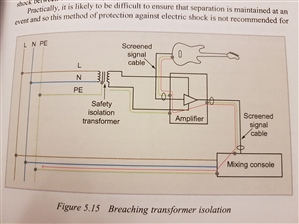perspicacious:
It won’t go away will it, surely if the problem is leakage current flowing along the signal cable screens disconnecting the appliance earth will just increase the current flowing along the signal cable screen?
Back to my observation earlier in this topic that asked:
I do wonder why, if the earth leakage from audio equipment is producing its own problem of "pleasurable noise" (sic), a better design of amplifiers is appropriate? Is it a case of the equipment design being the author of its own misfortune and reliant on an earth path to dump its byproducts?
And doesn't appear to have been challenged that the design poops on itself and all over those with sensitive hearing...............
Regards
BOD
It's not the audio equipment itself in a studio (or on stage) ... it's a mixture of the number of interconnected components, some of which can't be anything other than common-mode connected, but the whole potentially picking up stuff from elsewhere.
A few years back, BS EN 50310 actually had supply arrangements ranked effectively "not good" (TT), "better" (TN-C-S), "best" (TN-S), although to be honest that's only really relating to the performance of noise filters that include Line to Earth and Neutral to Earth "noise sinking", and it's a whopping generalisation too, which is probably why it doesn't say that any more.


We're about to take you to the IET registration website. Don't worry though, you'll be sent straight back to the community after completing the registration.
Continue to the IET registration site